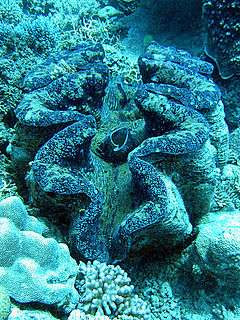Tridacninae
| Tridacninae Temporal range: Eocene - recent | |
|---|---|
 | |
| The Giant clam Tridacna gigas. | |
| Scientific classification | |
| Kingdom: | Animalia |
| Phylum: | Mollusca |
| Class: | Bivalvia |
| Order: | Veneroida |
| Family: | Cardiidae |
| Subfamily: | Tridacninae Lamarck, 1819 |
| Genera | |
|
See text | |
Tridacninae, common name, the giant clams, is a taxonomic subfamily of very large saltwater clams, marine bivalve mollusks in the family Cardiidae, the cockles.
Description
This family contains the largest living bivalve species, including Tridacna gigas, the giant clam. They have heavy shells, fluted with 4–6 folds. The mantle is usually brightly coloured. They inhabit coral reefs in warm seas in the Indo-Pacific region. Most of these clams live in symbiosis with photosynthetic dinoflagellates (zooxanthellae).
Systematics
Sometimes the giant clams are still treated as a separate family Tridacnidae,[1] but modern phylogenetic analyses included them in the family Cardiidae as a subfamily.[2][3] Two recent genera and eight species are known:
Recent genetic evidence has shown them to be monophyletic sister taxa.[4]
Human relevance
In some areas, such as the Philippines, smaller members of the family are farmed to supply the marine aquarium trade.
References
- ↑ WoRMS. (2009). Tridacnidae. Accessed through the World Register of Marine Species at http://www.marinespecies.org/aphia.php?p=taxdetails&id=196336 on 2009-01-10.
- ↑ Schneider,J. Phylogeny of cardiid bivalves (cockles and giant clams): revision of the Cardiinae and the importance of fossils in explaining disjunct biogeographical distributions. Zoological Journal of the Linnean Society, 2002,136, 321–369
- ↑ Keys,J.L., Helay,J.M. Relevance of Sperm Ultrastructure to the Classification of Giant Clams (Mollusca, Cardioidea, Cardiidae, Tridacninae)(in: Harper et al., (Eds) The Evolutionary Biology of the Bivalvia, Geological Society Special Publication No 177, 2000)
- ↑ Schneider, J.A.,and O´Foighil, D. Phylogeny of Giant Clams (Cardiidae: Tridacninae) Based on Partial Mitochondrial 16S rDNA Gene Sequences. Molecular Phylogenetics and Evolution Vol. 13, No. 1, October, pp. 59–66, 1999